Positioning.
Posted on | April 25, 2012 | 13 Comments
We don’t all get an easy start in life. Take little Tina. My friend’s Toggenburg goat had a difficult delivery. Her feet weren’t in the right position for birth and it took a lot of wrangling to free her. And when Tina was finally born, her front legs were weak and all crumpled up.
My friend and the vet tried the typical treatments for white muscle disease, in case it was that. But the treatments didn’t have any effect and the symptoms didn’t exactly match with white muscle disease anyway. Instead, it seemed that Tina’s difficult positioning during development caused her legs to be cramped up and now they were stuck in that position.
So, like all farmers, my friend was left in a difficult position herself. To intervene and risk complicating the issue as well as putting the animal through needless pain and discomfort? Or to leave it alone, hoping that it resolves itself, and doesn’t worsen to the point that it can’t be fixed? If you think this is what vets are for, then you haven’t stood in the office of the large animal vet and paid $150-200 for the vet to shrug and say, “Well, we can try and fix it or leave it and hope it fixes itself. You choose.” Sometimes even the best vets are left in the same position as the farmer.
Meanwhile, Tina went on with her life without a concern in the world.
No one told her she was in jeopardy. So she nursed. And she played. And although she couldn’t jump up on all the things that goat kids love to jump up on (buckets, logs, hay bales, their mommas), she did throw her front feet up on things and stand as best she could. When she got tired, she would kneel all the way down and rest, but she perfected a crab-like crawl that was actually very fast and got her wherever she wanted to go.
Best of all, those little legs started to relax a bit. The stiff U-shaped legs that she was born with started to stretch and she seemed to have more flexibility when you manipulated them. Which gave all of us hope that her vigor and zest for life was enough to resolve this issue on it’s own. Until this:
Her legs started to bow out. At 6 weeks old, she had, not just a stiff knee bend to contend with, but the tendency of her legs to bow way out to the side.
It seemed like her legs had loosened as much as they were going to. But the muscles weren’t getting strong enough for her to stand and her legs were developing a bad habit. That stance was not going to suit her in life.
Tina didn’t have any hope as a dairy goat with that stance. My friend has a small farm and a limited capacity to keep animals. She couldn’t keep Tina and she couldn’t sell her as a dairy goat. And it wasn’t just a matter of finding a rescue home for her. Toggenburgs are medium size goats but can still grow to 120lbs. How would all that weigh thrust onto Tina’s knees affect her life? Pain? Early arthritis? Increasing disability? So now comes the most difficult position of all. To allow a goat to head down a path leading to pain, disability, and a horrible death? Or to give her a humane ending now?
Or to give her just one more chance?
My friend had tried some splints, but none of them seemed strong enough to fight the tightness of those leg muscles. And Tina complained loudly about them. Or refused to move in them. Now that Tina’s legs had stretched a bit, we decided to give splints one last try. With a twist.
Tina came over here to my farm. Since Tina wasn’t born here, she wasn’t one of my babies. I had a lot more tolerance to listening to her cry than my friend, who was there when Tina was helped into this world. Plus, we discovered Tina had a huge incentive to get up and move, even in splints, around here. From the minute she arrived, she crab-crawled around joyfully with the other babies. Tina didn’t have any young playmates at my friend’s place. But here she had 2 lambs and 2 bucklings to run and butt and jump with, and she loved every second of it. Perhaps that would be incentive enough for to get up, even if she hated her splints.
We picked up Tina one evening before dinnertime. She spent that night and the next morning crab-crawling around and making friends. She got used to drinking Pepsi milk from a bottle.
She started eating grain.
I was worried that she would be picked on. Animals tend to have little tolerance for injured or weaker animals. But Tina didn’t know she was injured or weak. And she didn’t act like she was injured or weak. So the adults didn’t pay her any mind at all. And the young ones just treated her to the same rough housing that they treated each other. Perhaps the only moment of awkwardness was when she kept trying to nurse off of C.C. Bet she was thinking that was the mother lode of milk!
While Tina explored, I worked on the splints. I decided on PVC pipes to slide over her legs and hold them in a straighter position, allowing the muscles and tendons to stretch. If the splints kept her toe on the ground then I hoped her legs would gain strength, too. I measured Tina’s leg by sliding a paper towel tube over it and cutting it fit. Then I scrounged behind the shed for some matching PVC pipe. The 1 1/2″ pipe matched the width of the paper towel tube so I headed to the deck with an assortment of saws and a clamp.
Blackbeard immediately arrived to beg for some dog food. When I told her I was busy, she started eating my lilies right in front of me in order to make me unbusy.
By the time I had Blackbeard settled, Daisy had arrived. She felt that the clamp was not as important for holding down a PVC pipe while I cut it as it was an excellent cheek scratcher.
However, when she saw my wildy erratic sawing motions, the way I needed to switch to 3 different saws to accomplish the job, and how the clamp came undone twice because I wasn’t exactly sure how to fasten it, she decided a retreat to the lilies was the safer option.
I’m not really sure why I try to grow flowers on the deck. They don’t get any respect.
After the splints were cut to size…
…I drilled holes so I could attach them with rope or string if I needed to. I figured I could tape the splints in place, but I drilled the holes just in case. I thought it was very clever of me to give me myself a second attachment option. That way I avoided having to take the splints off, come back in the house to drill holes, and then go back out and put them back on.
Too bad the 1 1/2″ pipe was just too tight. I guess the paper towel tube had a little more give than the PVC. Because trying to get the splint over her knee on the right leg seemed impossible without causing Tina a lot of pain. So I had to take the splints off, go to the shed for 2″ PVC pipe, cut it to length on the deck, come back in the house to drill holes, and then go back out and put them back on. I am not always as clever as I think I am.
But together Pretty and I were able to slowly and carefully slide the 2″ PVC splints all the way up her legs, almost to the elbows. We had to take our time and her muscles shook as we did it, but she didn’t cry out in pain or struggle desperately to get away. Which told us it wasn’t too much for her to handle.
We padded her elbows good so the splint could rest against her legs without hurting her.
We tied twine to the splint.
We slowly slid the splint up the leg, straightening as we went.
We tied the twine together over her shoulders to act as suspenders, padded it with a towel so that it wouldn’t irritate her, and then taped the splints to the legs, too.
We tried to sit the splints so that her toes were just at the edge of the PVC pipe, so she is standing on them—helping to support herself and gaining strength in her legs.
Then it was time for the moment of truth. We had never seen a goat with Tina’s deformity. We had never made splints. We had no idea what to expect. We had absolutely no experience in this area. Which had never stopped us before. Because we had hope.
And when she stood up and started walking around, we had joy.
Oh, don’t get me wrong. Tina is not particularly impressed with our efforts. Whenever I come out on the deck, she leaves off playing with the other babies and comes to fence to ask where her mother is and if this treatment has been authorized.
Luckily, I am not moved by her display. I do have many years experience in responding to a complaining youngster by saying, “You’re fine. Go play.” So eventually she does. Besides, I know by her behavior that she is not really in pain. And she is walking upright. Her legs are in a much better position than they were. And she might not know it, but so is her life.
We plan to take the splints off after a certain number of days (3 days? a week? 2 weeks?). If her legs are sufficiently straighter, we will move to the 1 1/2″ splints that I so cleverly made in advance. We may even shorten those splints to allow more of her hooves to touch the ground.
If her legs are straight enough. If her legs are strong enough.
But I have hope. Which can sometimes be just as powerful as experience. I have hope that we are maybe, possibly, positioned for success. And it’s a good position to be in.
**All ideas, suggestions, helpful hints, and random observations are welcome!**
Can you help Tina? If you have any ideas on what we can do better, please let us know. I am most concerned about:
1. How long to leave the splints on?
2. How can we increase her leg strength while the splints are on?
3. What supplements (vitamins, herbals, homeopathic, etc) can speed her healing, decrease her discomfort, or increase her strength?
Comments

13 Responses to “Positioning.”
Leave a Reply
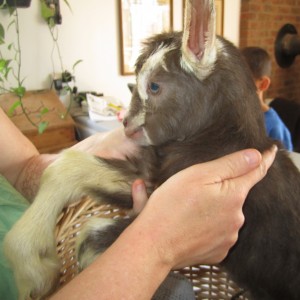
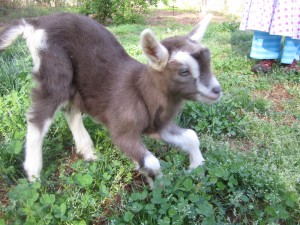
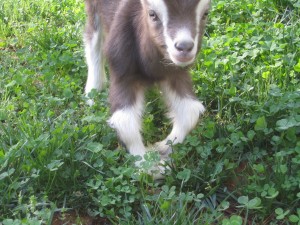
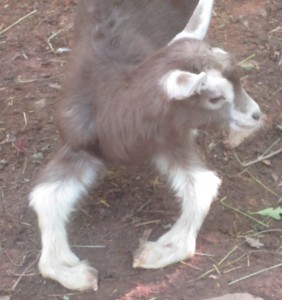
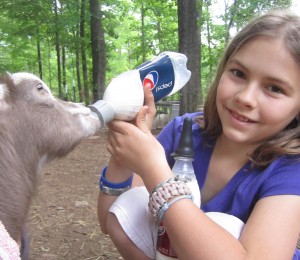
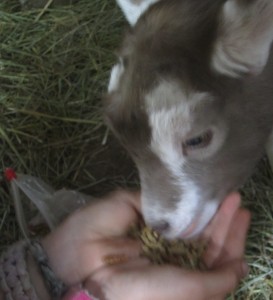
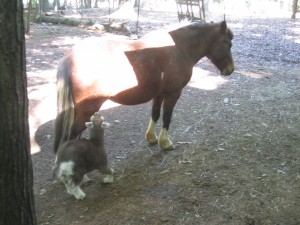
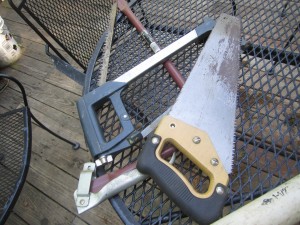
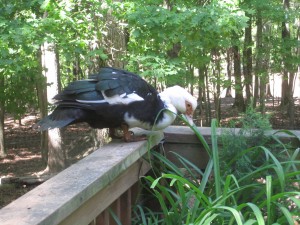
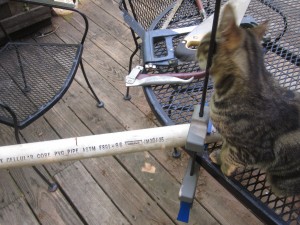
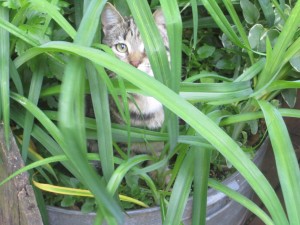

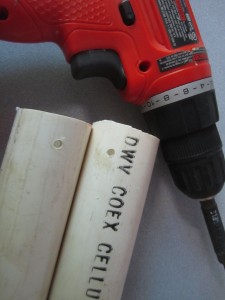
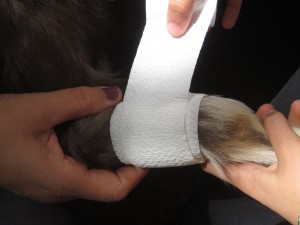
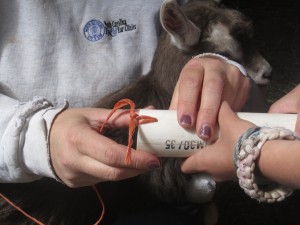
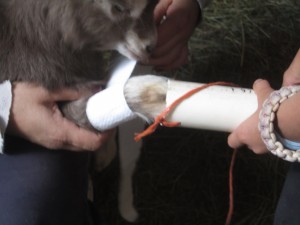
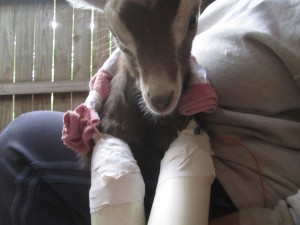
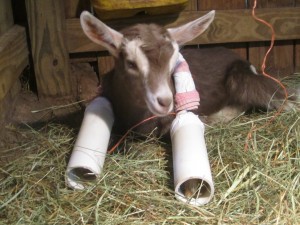
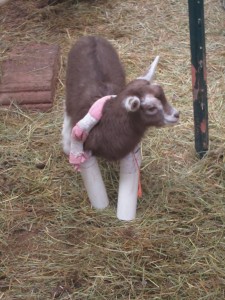
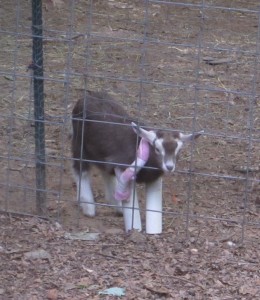



April 25th, 2012 @ 4:21 pm
I offer no help or knowledge. Just a round of wild clapping and hoots of encouragement for Tina and her human helpers.
April 25th, 2012 @ 6:04 pm
Wow, good luck!
April 25th, 2012 @ 7:53 pm
Wow. What a little trooper. Animals continue to amaze me. I have absolutely no experience or authority or knowledge, but my gut says, give her legs a break every now and then, so the muscles aren’t overly stressed and tire too much. I would take the splints off every night so she can sleep without them on. It would seem to me that if the muscles are worked too hard, too fast, just like us after a really strenuous exercise, they need time to recuperate and may weaken, rather than strengthen. Totally a hunch, though. You go with your gut, it seems to be working for you, so far.
April 26th, 2012 @ 6:15 am
Recently I too experienced raising a baby goat with leg weakness. Only it was her hind legs and I received her just hours old. She couldn’t stand on her own and her legs too were in a crabbed position. I had no training or experience to fall back on for help, so like you just used some common sense to try to relieve the situation. I massaged her legs and back and gently stretched her leg muscles. Luckily within days she could stand on her own and very shortly afterwards was walking on carpeted floors. By the end of 3 weeks walking, running and jumping with minimal difficulties. I then gave her to a friend with 4 young children and they provided her with much more exercise than I could ever provide. We did give her a pro-biotic paste for added vitamins and minerals too. I think Carolyn’s suggestion of splint rest makes sense too.
April 26th, 2012 @ 6:21 am
Go Tina! Or I guess that should be Go play, Tina! 🙂 Loved reading this uplifting farm story. Great job you’ve done so far. Tell Tina we’re all rooting for her! 🙂
April 26th, 2012 @ 8:52 am
Beautiful story about the ingenuity of farmers! I hope it has a happy ending for all of you.
April 26th, 2012 @ 10:33 am
You are amazing! I think this could get published…. And I am hoping for the best –
April 26th, 2012 @ 11:09 am
Can’t wait to see how this goes…am keeping all my fingers crossed for you both. I would go with some splint rest, perhaps every other day (in case she gets up and walks around in the night and tries to prance around) and keep them on as long as she will tolerate them…a few weeks, perhaps?
April 26th, 2012 @ 1:17 pm
Well done you and Pretty, I love that sometimes owners know better than vets! I would suggest massaging the legs a couple of times a week, that will give Tina some splint rest and gentle massage of the ligaments will get her supple and ready for jumping with the others. Let us know what happens!
April 26th, 2012 @ 6:07 pm
HOORAY! Wow, you have the biggest heart! I really admire your spirit and your quest for helping this little one. I sure hope that love and persistence helps her gain strength to live a good long goatie life!
I don’t have a clue about such things, but I do agree with giving her a rest every few days. I would think massage and checking for bruises, cuts, or rubbing from the tubes on her legs would be important.
Oh, I sure hope you can save her!
February 12th, 2013 @ 3:15 pm
Since I’m still getting caught up on old reruns of the Stevie show, and this episode is already 10 months old, this advice is probably moot except for future reference…
Soooo, I broke a finger once such that I tore a bunch of the connective tissue holding the joint together. After a few months in a splint that immobilized my finger in a 90 degree angle, the end result was that all my ligaments and tendons healed in a flexed position…not to mention the weakness that resulted due to atrophy. I was prescribed a device that used rubber bands that forced the joint to extend. Google “rubber band finger splint” to see what I mean. It’s a relatively simple device, and looks like something you could fashion out of PVC pipe and some wood dowels.
The doc had me wear that thing on some intermittent regimen (like an hour, four times a day…or something) that I don’t remember. I had to use that thing for like eight weeks.
Anyway, probably too little too late, but maybe it’ll come in handy down the road.
May 4th, 2016 @ 10:50 am
Hi have a 3 day old lamb with similar leg problems- looks just like Tina’s front legs. Gave him bo se and baby asprin and have massaged his legsI am going to try your solution. He does not seem to be in pain.thanks for posting
Claire
January 22nd, 2018 @ 7:33 am
I have a lamb in this exact situation. Im meeding advice. Was the splinting successful??? Im torn between ending her suffering or trying to work through this.